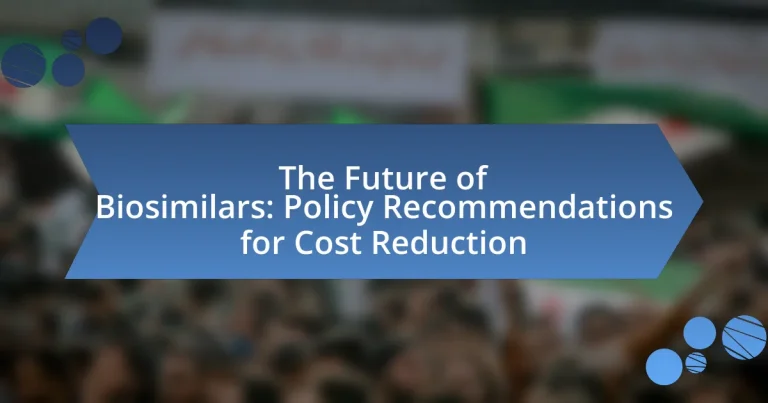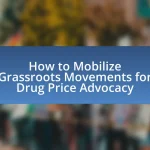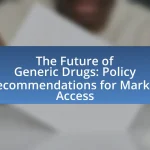Biosimilars are biologic medical products that are highly similar to already approved reference biologics, offering significant potential for cost reduction in healthcare. This article explores the importance of biosimilars in providing affordable treatment options, their differences from original biologics, and the rigorous approval process that ensures their safety and efficacy. It highlights the economic impact of biosimilars, including projected savings for the U.S. healthcare system, and discusses policy recommendations to enhance their market adoption, improve patient access, and address challenges such as regulatory hurdles and market dynamics. The article emphasizes the need for collaboration among stakeholders to promote the successful integration of biosimilars into healthcare systems.
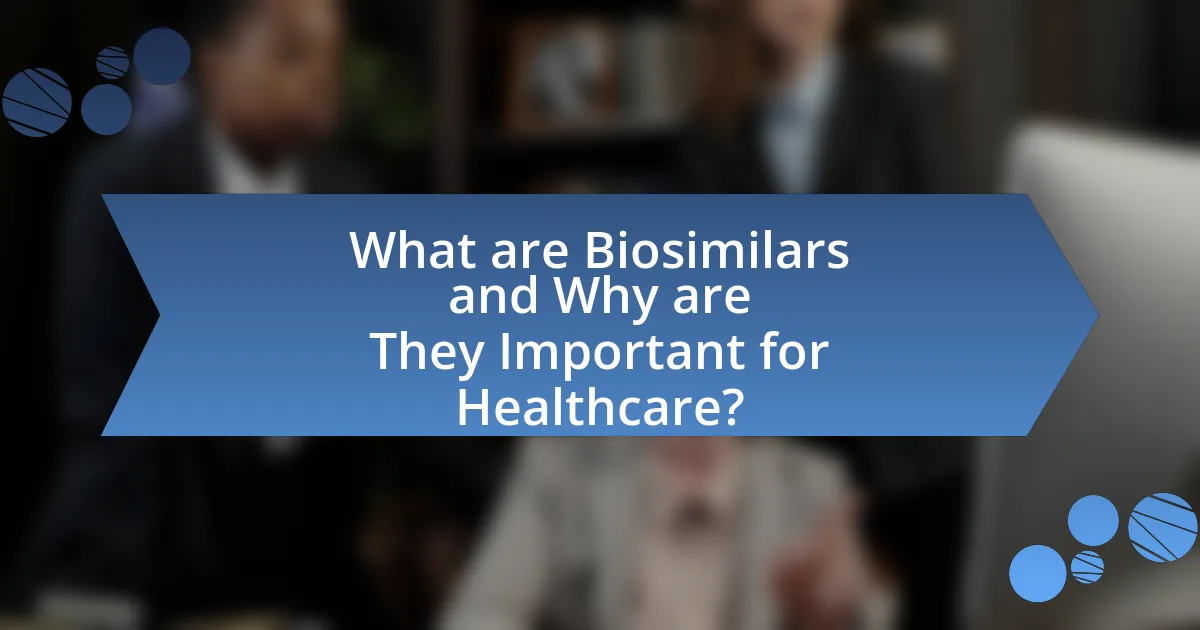
What are Biosimilars and Why are They Important for Healthcare?
Biosimilars are biologic medical products highly similar to already approved reference biologics, with no clinically meaningful differences in safety, purity, or potency. They are important for healthcare because they provide more affordable treatment options, potentially reducing healthcare costs and increasing patient access to essential therapies. According to a report by the IQVIA Institute for Human Data Science, biosimilars could save the U.S. healthcare system approximately $54 billion by 2026, demonstrating their significant economic impact.
How do Biosimilars differ from Original Biologics?
Biosimilars differ from original biologics primarily in their manufacturing processes and regulatory approval pathways. Original biologics are complex molecules produced through living organisms, while biosimilars are highly similar versions of these biologics, designed to match the reference product in terms of safety, efficacy, and quality. The U.S. Food and Drug Administration (FDA) requires biosimilars to demonstrate similarity to the original biologic through extensive analytical, preclinical, and clinical studies, but they do not need to replicate the original biologic’s manufacturing process. This distinction allows for potentially lower development costs and increased market competition, which can lead to reduced prices for patients.
What are the key characteristics that define Biosimilars?
Biosimilars are biologic medical products that are highly similar to an already approved reference biologic product. Key characteristics that define biosimilars include structural similarity, functional similarity, and no clinically meaningful differences in safety or efficacy compared to the reference product. Regulatory agencies, such as the FDA and EMA, require extensive analytical, preclinical, and clinical data to demonstrate these characteristics, ensuring that biosimilars can be used interchangeably with their reference products. The approval process for biosimilars is designed to confirm that any minor differences in clinically inactive components do not affect the overall therapeutic outcome.
Why is the approval process for Biosimilars significant?
The approval process for biosimilars is significant because it ensures the safety, efficacy, and quality of these biologic products, which are designed to be highly similar to already approved reference biologics. This rigorous evaluation is crucial as it fosters competition in the pharmaceutical market, potentially leading to lower drug prices and increased patient access to essential therapies. According to a study published in the Journal of Managed Care & Specialty Pharmacy, the introduction of biosimilars has the potential to reduce healthcare costs by billions of dollars annually, demonstrating the economic impact of a well-regulated approval process.
What role do Biosimilars play in reducing healthcare costs?
Biosimilars play a significant role in reducing healthcare costs by providing lower-cost alternatives to expensive biologic medications. These products are designed to be highly similar to already approved biologics, which allows for increased competition in the market. For instance, studies have shown that the introduction of biosimilars can lead to price reductions of 20% to 30% compared to their reference products, as evidenced by the 2019 report from the IQVIA Institute for Human Data Science. This competitive pricing not only lowers the direct costs for patients and healthcare systems but also encourages more widespread access to essential therapies, ultimately contributing to overall healthcare savings.
How can Biosimilars improve patient access to treatments?
Biosimilars can improve patient access to treatments by providing more affordable alternatives to expensive biologic medications. The introduction of biosimilars into the market typically leads to reduced prices due to increased competition, which can lower overall healthcare costs. For instance, studies have shown that the availability of biosimilars can reduce the price of reference biologics by 20% to 40%, making treatments more accessible to patients who may have previously faced financial barriers. Additionally, the increased availability of biosimilars can enhance treatment options for patients, particularly in therapeutic areas such as oncology and autoimmune diseases, where biologics are commonly used.
What evidence exists to support cost savings from Biosimilars?
Evidence supporting cost savings from biosimilars includes multiple studies demonstrating significant reductions in healthcare expenditures. For instance, a study published in the Journal of Managed Care & Specialty Pharmacy found that the introduction of biosimilars for the treatment of rheumatoid arthritis led to a 30% decrease in drug costs compared to their reference biologics. Additionally, the IQVIA Institute for Human Data Science reported that biosimilars saved the U.S. healthcare system approximately $7.6 billion in 2020 alone. These findings indicate that biosimilars can effectively lower treatment costs while maintaining therapeutic efficacy.
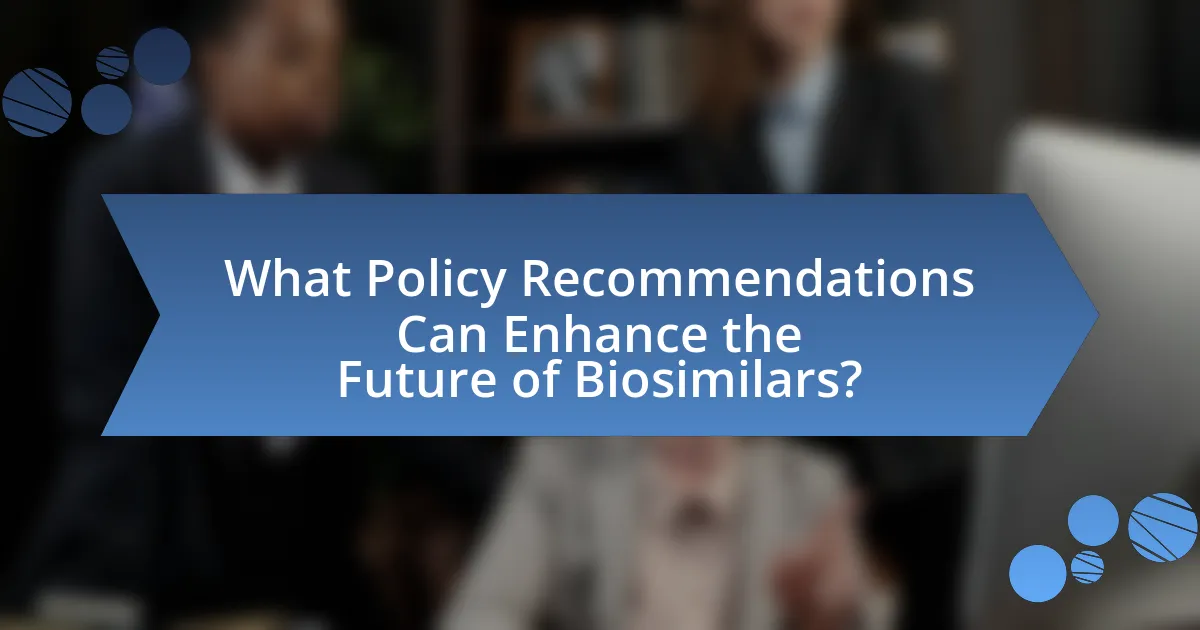
What Policy Recommendations Can Enhance the Future of Biosimilars?
Policy recommendations that can enhance the future of biosimilars include streamlining regulatory pathways, improving market access, and fostering competition. Streamlining regulatory pathways, such as adopting a more efficient approval process for biosimilars, can reduce time and costs associated with bringing these products to market. For instance, the FDA’s 2015 guidance on biosimilars has already facilitated quicker approvals, demonstrating the effectiveness of such policies. Improving market access through policies that encourage the inclusion of biosimilars in formularies and reimbursement schedules can further enhance their uptake. Additionally, fostering competition by eliminating anti-competitive practices, such as pay-for-delay agreements, can lead to lower prices and increased availability. Evidence from countries with robust biosimilar markets, like Germany, shows that these strategies can significantly reduce healthcare costs while maintaining patient access to essential medications.
How can regulatory frameworks be improved for Biosimilars?
Regulatory frameworks for biosimilars can be improved by adopting a more streamlined approval process that emphasizes scientific evidence and real-world data. This approach would facilitate faster market entry for biosimilars, thereby increasing competition and reducing costs. For instance, the European Medicines Agency has successfully implemented a pathway that allows for the use of extrapolated data from reference biologics, which can significantly shorten the time and resources needed for approval. Additionally, enhancing collaboration between regulatory agencies and stakeholders, including manufacturers and healthcare providers, can lead to more informed guidelines that reflect the latest scientific advancements and patient needs. This collaborative effort can also help in establishing clear standards for interchangeability and substitution, which are critical for market acceptance and utilization of biosimilars.
What changes are needed in the approval process for Biosimilars?
The approval process for biosimilars requires a shift towards more streamlined regulatory pathways and enhanced scientific guidance. Regulatory agencies should implement clearer guidelines that define the necessary data for demonstrating biosimilarity, which would reduce the uncertainty and variability in submissions. Additionally, adopting a more flexible approach to clinical trial requirements, particularly for well-characterized biologics, could expedite approvals. Evidence from the European Medicines Agency indicates that a more efficient approval process can lead to increased market entry of biosimilars, ultimately driving down costs and improving patient access.
How can transparency in pricing be increased for Biosimilars?
Transparency in pricing for biosimilars can be increased through standardized pricing frameworks and enhanced regulatory oversight. Implementing a uniform pricing model across different markets would allow stakeholders to compare costs more effectively. Additionally, regulatory bodies can mandate that manufacturers disclose detailed pricing information, including production costs and pricing strategies, which would provide clearer insights into the pricing structure. Studies have shown that transparency initiatives, such as the introduction of price transparency laws in various regions, have led to reduced prices and increased competition in the pharmaceutical market.
What strategies can promote the adoption of Biosimilars?
Strategies that can promote the adoption of biosimilars include enhancing education for healthcare providers and patients, implementing supportive regulatory frameworks, and establishing financial incentives. Education initiatives can increase awareness and understanding of biosimilars, addressing misconceptions and fostering trust in their efficacy and safety. Regulatory frameworks that streamline the approval process for biosimilars can facilitate quicker market entry, while financial incentives, such as reduced co-pays or rebates, can encourage both prescribers and patients to choose biosimilars over more expensive biologics. Evidence from markets where these strategies have been implemented shows increased biosimilar uptake, leading to cost savings and improved patient access to essential therapies.
How can healthcare providers be incentivized to prescribe Biosimilars?
Healthcare providers can be incentivized to prescribe biosimilars through financial incentives, education on cost-effectiveness, and streamlined approval processes. Financial incentives, such as higher reimbursement rates for biosimilars compared to reference biologics, encourage providers to choose these alternatives. Education initiatives that highlight the clinical efficacy and safety of biosimilars can address misconceptions and build provider confidence. Additionally, simplifying the regulatory pathway for biosimilars can facilitate their adoption by reducing administrative burdens. Evidence from studies indicates that when financial and educational incentives are implemented, biosimilar adoption rates increase significantly, leading to cost savings for both healthcare systems and patients.
What role do educational initiatives play in increasing awareness of Biosimilars?
Educational initiatives play a crucial role in increasing awareness of biosimilars by providing accurate information and addressing misconceptions among healthcare professionals and patients. These initiatives, such as workshops, seminars, and informational campaigns, educate stakeholders about the safety, efficacy, and cost-effectiveness of biosimilars compared to their reference biologics. For instance, a study published in the Journal of Managed Care & Specialty Pharmacy found that educational programs significantly improved healthcare providers’ knowledge and attitudes towards biosimilars, leading to increased acceptance and utilization. By enhancing understanding and trust, educational initiatives facilitate informed decision-making, ultimately promoting the adoption of biosimilars in clinical practice.

What Challenges Must Be Addressed for the Successful Integration of Biosimilars?
The successful integration of biosimilars faces several challenges, including regulatory hurdles, physician and patient acceptance, and market access issues. Regulatory hurdles arise from the need for comprehensive clinical data to demonstrate biosimilarity, which can delay approval processes. Physician acceptance is critical, as many healthcare providers may be hesitant to prescribe biosimilars due to concerns about efficacy and safety compared to original biologics. Market access issues stem from the complex pricing and reimbursement landscape, where biosimilars may struggle to compete with established biologics. Addressing these challenges is essential for maximizing the potential of biosimilars to reduce healthcare costs and improve patient access to therapies.
What are the barriers to market entry for Biosimilars?
The barriers to market entry for biosimilars include regulatory hurdles, high development costs, and market access challenges. Regulatory hurdles arise from the need for extensive clinical data to demonstrate similarity to reference biologics, which can be time-consuming and expensive. High development costs are driven by the complexity of biologics and the need for specialized manufacturing processes, often exceeding hundreds of millions of dollars. Market access challenges stem from the existing market dominance of originator biologics, which can lead to reluctance from healthcare providers and payers to adopt biosimilars. These barriers collectively hinder the timely introduction of biosimilars into the market, limiting competition and potential cost savings for patients and healthcare systems.
How do patent issues affect the availability of Biosimilars?
Patent issues significantly restrict the availability of biosimilars by prolonging the exclusivity period of original biologic drugs. When a biologic is patented, competitors cannot legally produce biosimilars until the patent expires, which can take up to 20 years. This delay limits market entry for biosimilars, reducing competition and keeping prices high. For instance, the introduction of biosimilars in the U.S. has been slow due to complex patent litigation and the strategic use of patent thickets by original manufacturers, which can extend their market dominance. Consequently, the lack of timely biosimilar availability directly impacts healthcare costs and patient access to affordable treatment options.
What impact do market dynamics have on Biosimilar competition?
Market dynamics significantly influence biosimilar competition by affecting pricing strategies, market entry barriers, and overall market share. For instance, increased competition among biosimilars can lead to lower prices, as seen in the U.S. market where the introduction of multiple biosimilars for the same reference product has resulted in price reductions of up to 30% or more. Additionally, regulatory frameworks and patent expirations create opportunities for new entrants, thereby enhancing competition. The presence of strong market players can also dictate pricing and availability, as demonstrated by the rapid uptake of biosimilars in Europe, where favorable policies have led to a higher market penetration rate compared to the U.S. These dynamics collectively shape the competitive landscape, driving innovation and cost reduction in the biosimilar sector.
How can stakeholders collaborate to overcome challenges?
Stakeholders can collaborate to overcome challenges by establishing clear communication channels, sharing resources, and aligning their goals towards common objectives. For instance, pharmaceutical companies, healthcare providers, and policymakers can engage in regular dialogues to identify barriers to biosimilar adoption and develop joint strategies to address them. Evidence from the Biosimilars Council indicates that collaborative efforts, such as public-private partnerships, have successfully reduced costs and improved access to biosimilars in various markets. By leveraging each stakeholder’s expertise and resources, they can create a more efficient ecosystem that fosters innovation and enhances patient access to affordable treatments.
What partnerships are essential for advancing Biosimilar policies?
Collaborations between regulatory agencies, healthcare providers, pharmaceutical companies, and patient advocacy groups are essential for advancing biosimilar policies. Regulatory agencies, such as the FDA and EMA, play a crucial role in establishing guidelines that ensure the safety and efficacy of biosimilars. Healthcare providers must be engaged to facilitate the integration of biosimilars into treatment protocols, while pharmaceutical companies are vital for developing and supplying these products. Patient advocacy groups contribute by raising awareness and educating patients about the benefits of biosimilars, which can lead to increased acceptance and utilization. These partnerships create a comprehensive ecosystem that supports the development, approval, and adoption of biosimilars, ultimately contributing to cost reduction in healthcare.
How can patient advocacy groups influence Biosimilar acceptance?
Patient advocacy groups can influence biosimilar acceptance by educating patients and healthcare providers about the safety and efficacy of biosimilars. These groups often conduct outreach programs, disseminate information through various media, and engage in discussions with stakeholders to address misconceptions and build trust. For instance, studies have shown that informed patients are more likely to accept biosimilars, as evidenced by a survey published in the Journal of Managed Care & Specialty Pharmacy, which indicated that 70% of patients expressed a willingness to switch to a biosimilar when provided with adequate information. By leveraging their networks and resources, patient advocacy groups can effectively advocate for policies that promote biosimilar use, ultimately contributing to cost reduction in healthcare.
What Best Practices Should Be Followed for Implementing Biosimilar Policies?
Best practices for implementing biosimilar policies include establishing clear regulatory pathways, ensuring robust education and communication strategies, and promoting stakeholder engagement. Clear regulatory pathways, such as those established by the FDA, facilitate the approval process for biosimilars, ensuring safety and efficacy while encouraging market entry. Education initiatives for healthcare providers and patients about the benefits and differences of biosimilars compared to reference biologics can enhance acceptance and utilization. Furthermore, engaging stakeholders, including manufacturers, healthcare professionals, and patient advocacy groups, fosters collaboration and addresses concerns, ultimately leading to more effective policy implementation. These practices are supported by evidence from various health policy studies indicating that structured approaches lead to increased biosimilar adoption and cost savings in healthcare systems.
How can policymakers ensure equitable access to Biosimilars?
Policymakers can ensure equitable access to biosimilars by implementing regulatory frameworks that promote affordability and availability. This includes establishing clear pathways for biosimilar approval, which can reduce development costs and encourage competition. For instance, the FDA’s Biosimilar User Fee Act has facilitated faster market entry for biosimilars, leading to lower prices. Additionally, policymakers can incentivize healthcare providers to prescribe biosimilars through education and reimbursement strategies that favor these alternatives. Evidence shows that countries with supportive policies, such as Germany, have seen increased biosimilar uptake, resulting in significant cost savings for healthcare systems.
What lessons can be learned from countries with successful Biosimilar markets?
Countries with successful biosimilar markets demonstrate that robust regulatory frameworks, effective pricing strategies, and strong stakeholder engagement are essential for market growth. For instance, Germany’s biosimilar market flourished due to its early adoption of biosimilars, supported by a clear regulatory pathway and incentives for physicians to prescribe these alternatives. Additionally, the UK’s National Health Service has effectively utilized biosimilars to reduce drug costs, achieving savings of approximately £200 million annually. These examples illustrate that policies promoting competition, transparency in pricing, and education for healthcare providers can significantly enhance the uptake of biosimilars, ultimately leading to reduced healthcare costs and improved patient access to essential medications.
